Apart from being arguably the most famous state for Hollywood, surfing, and steamy beaches, California also provides lots of opportunities for birdwatching. Numerous species of raptors live in the state. This is no surprise when you consider California’s diverse ecosystems, like the fog-shrouded redwood forests, inland marshes, the Mojave Desert, and arid chaparral.
Among the many birds of prey that inhabit California are a dozen species of hawks. The state offers different birding hotspots for watching hawks and other bird species. From the forests and the rocky shores of the north to the mountains of the east, you will be able to catch at least sight of a variety of hawks within the state. Below, we have listed 14 types of hawks you can find in the state of California.
Let’s take a look!
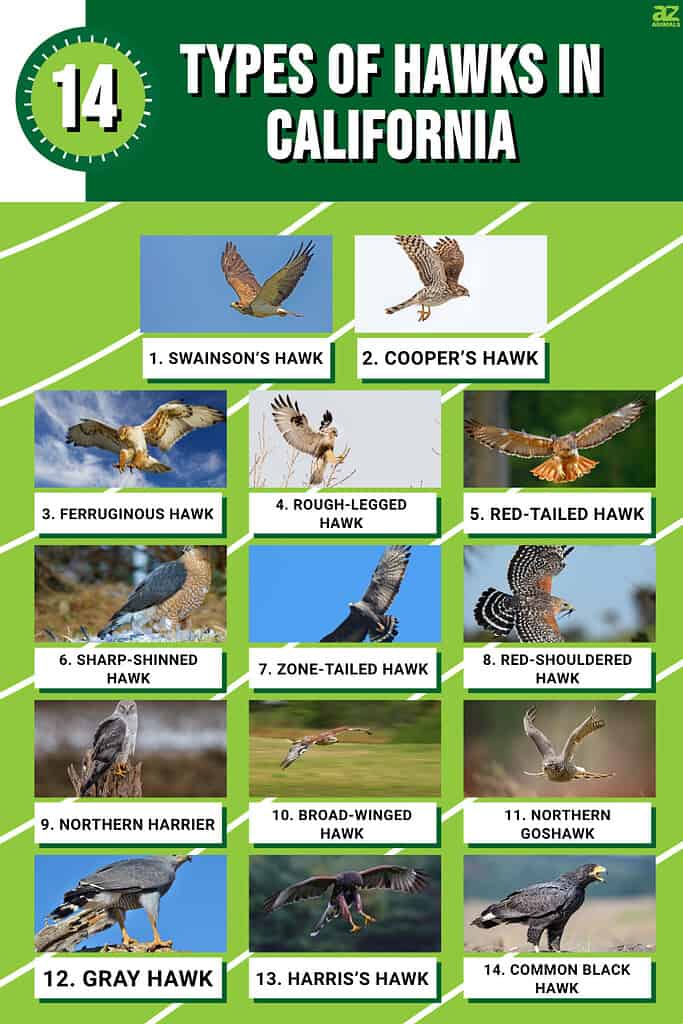
1. Swainson’s Hawk
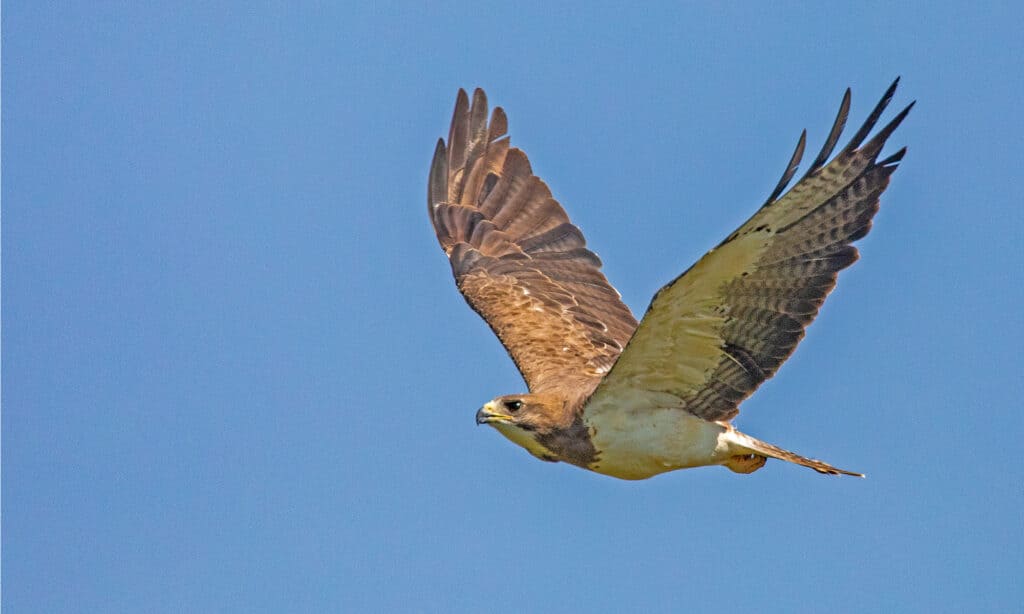
Swainson’s hawks feed primarily on large insects, small birds, pocket gophers, ground squirrels, snakes, mice, etc.
©Lowell Monke/Shutterstock.com
| Swainson’s Hawk | |
|---|---|
| Scientific name | Buteo swainsoni |
| Weight | 1.1–3.7 lbs (499-1678 g) |
| Height | 17-22 in (43-56 cm) |
| Wingspan | 46-54 in (117–137 cm) |
Swainson’s hawks can be found in the prairies and grasslands in California. They are fairly large hawks with short tails and broad wings. They vary in color, but most are gray or brown on the upper parts of their wings and dark or reddish-brown underneath.
These hawks enjoy migrating from time to time, with other bird species forming flocks of thousands as they travel. Swainson’s hawks feed primarily on large insects, small birds, pocket gophers, ground squirrels, snakes, mice, and sometimes carrion or bats. They hunt these mammals from the air by soaring over the vegetation. However, it’s not surprising to see a Swainson’s hawk walking on foot in the farmlands trying to catch insects and other prey.
Males choose the nesting site, usually on top of a solitary tree that is visible for miles in the grasslands or agricultural fields. They may also build their nests on top of trees along a stream. Females lay two to four eggs, incubating them for about 28 to 35 days.
2. Cooper’s Hawk

Cooper’s hawks mainly eat band-tailed pigeons, rock doves, common grackles, squirrels, and other small mammals.
©Richard G Smith/Shutterstock.com
| Cooper’s Hawk | |
|---|---|
| Scientific name | Accipiter cooperii |
| Weight | 7.8-14.5 oz (220-410 g) |
| Height | 14-20 in (35-50 cm) |
| Wingspan | 24-39 in (62-99 cm) |
Cooper’s hawks are medium-sized birds of prey with wide rounded wings and large shoulders. They are blue-gray on top and have reddish bars underneath. These birds are found in California year-round, and they inhabit almost all types of habitats, but most of them prefer the woodlands.
Cooper’s hawks mainly eat band-tailed pigeons, rock doves, common grackles, squirrels, and other small mammals. They also get attacked and can be eaten by foxes, snakes, raccoons, owls, eagles, and other bigger hawks.
They nest in deeper forests, mainly on flat grounds, not hillsides. Females lay around three to four eggs in a clutch, and they are in charge of incubation.
3. Ferruginous Hawk
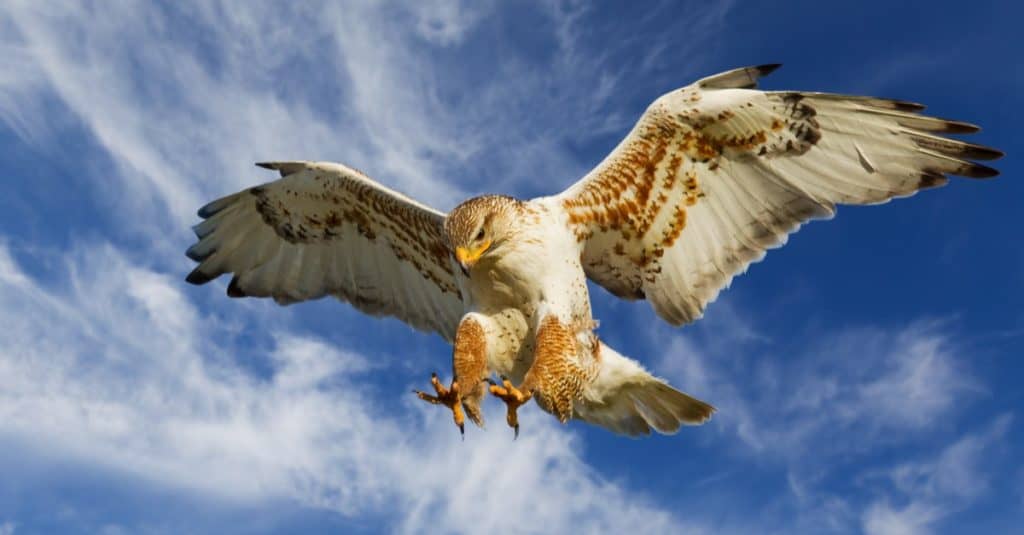
Ferruginous hawks hunt by watching their prey from a perch or the sky.
©Stephen Mcsweeny/Shutterstock.com
| Ferruginous Hawk | |
|---|---|
| Scientific name | Buteo regalis |
| Weight | 32 to 80 oz (907 to 2,268 g) |
| Height | 20 to 27 in (51 to 69 cm) |
| Wingspan | 52-56 in (133-142 cm) |
Ferruginous hawks can hardly be sighted in California except during the winter. In winter, they inhabit the farmlands, open fields, prairies, and deserts. Explore the plains and grasslands for a better chance to view these rare creatures.
These hawks are relatively large hawks with fairly long wings and pale heads. Their upper parts are a bit rusty, while their underparts are strikingly white. Their young ones have brown spots on their bellies.
Ferruginous hawks feed on rats, kangaroo rats, pocket gophers, cottontails, ground squirrels, jackrabbits, large insects, snakes, and other small birds. They hunt by watching their prey from a perch or the sky. They usually hunt on the ground as well.
Females lay around three to five eggs. Both parents take turns incubating the eggs. After hatching, the males provide food for the females and nestlings for the first three weeks. The nestlings are ready to fly out in seven weeks.
4. Rough-Legged Hawk
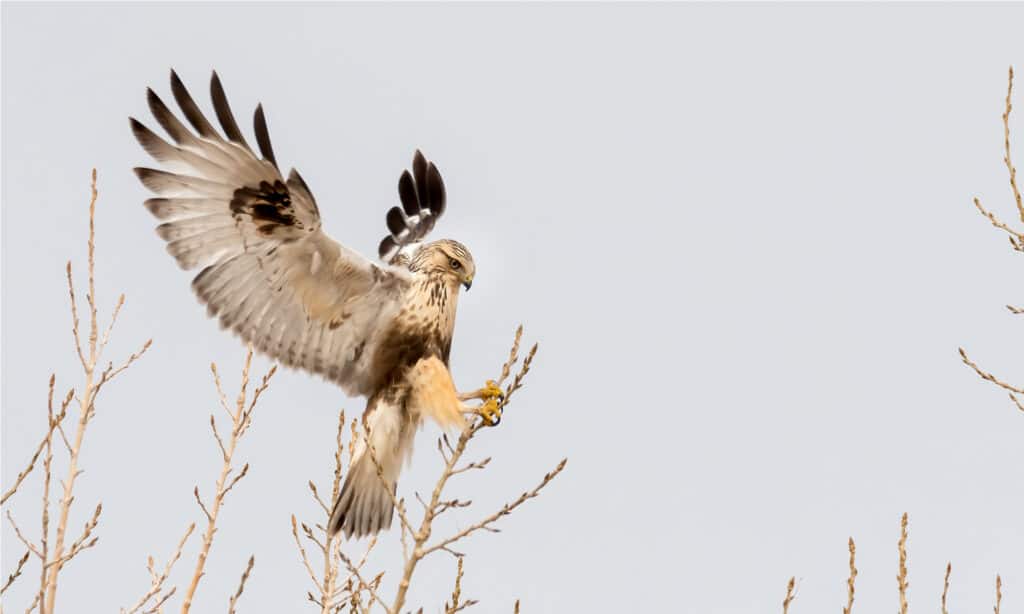
Rough-legged hawks breed throughout some of the arctic regions of California.
©Eivor Kuchta/Shutterstock.com
| Rough-Legged Hawk | |
|---|---|
| Scientific name | Buteo lagopus |
| Weight | 1.32-3.66 lbs (599-1660 g) |
| Height | 18-24 in (46-60 cm) |
| Wingspan | 52-54 in (132-138 cm) |
Rough-legged hawks can be sighted around cliffs in some forests in California. They are fairly large hawks with dark heads and streaked plumage. They have feathers on their legs, making them different from other species of hawk.
Rough-legged hawks primarily feed on rodents such as voles and lemmings during their breeding season. Their diet consists mainly of voles, rabbits, squirrels, mice, and shrews in winter. Like large falcons and golden eagles, some raptors prey on rough-legged hawks.
Rough-legged hawks breed throughout some of the arctic regions of California. They migrate to open deserts, prairies, and fields in winter.
5. Red-Tailed Hawk
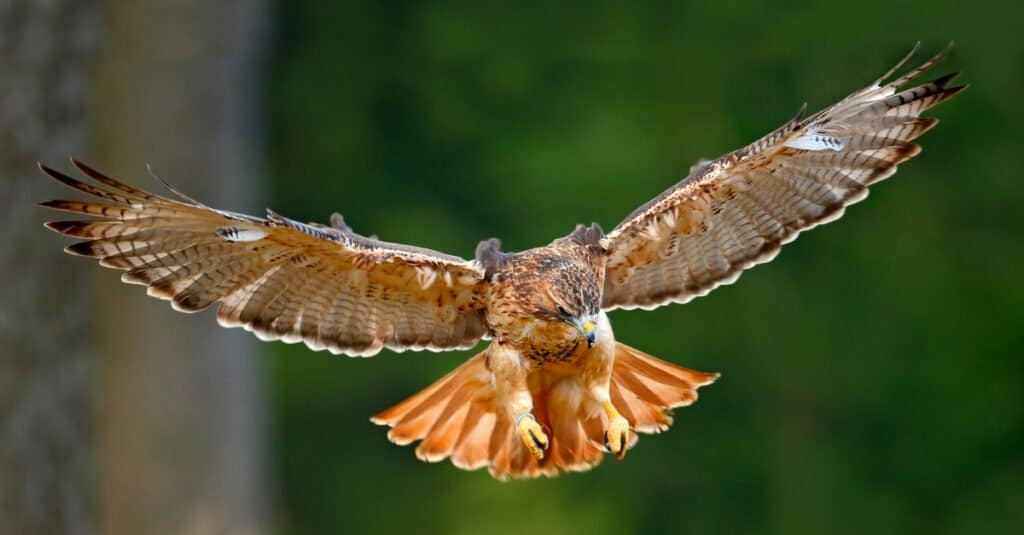
Red-tailed hawks build their nests in dense hardwood forests.
©Ondrej Prosicky/Shutterstock.com
| Red-Tailed Hawk | |
|---|---|
| Scientific name | Buteo jamaicensis |
| Weight | 1.5-3.5 lbs (680-1586 g) |
| Height | 18-26 in (45-65 cm) |
| Wingspan | 43-56 in (110-141 cm) |
Red-tailed hawks are very common in California. You can easily see them perched on a post or soaring in the sky in the countryside. So, you don’t have to visit a park to see one. These hawks inhabit any type of ecosystem – from woodlands to grasslands.
You’ll notice the dark brown wings if you see a red-tailed hawk from above. They appear pale from underneath, with a streaked belly. They have red tails, though they’re brown and banded in immature hawks.
Red-tailed hawks mainly feed on ground squirrels, voles, rats, rabbits, and small mammals. They spend most of their time soaring in the open fields where there’s pasture to hut for rabbits and voles. They have to evade potential predators like great-horned owls and bobcats while they are out in the open.
Red-tailed hawks build their nests in dense hardwood forests. They are very solitary and secretive nesters. Females lay one to four eggs each year.
6. Sharp-Shinned Hawk
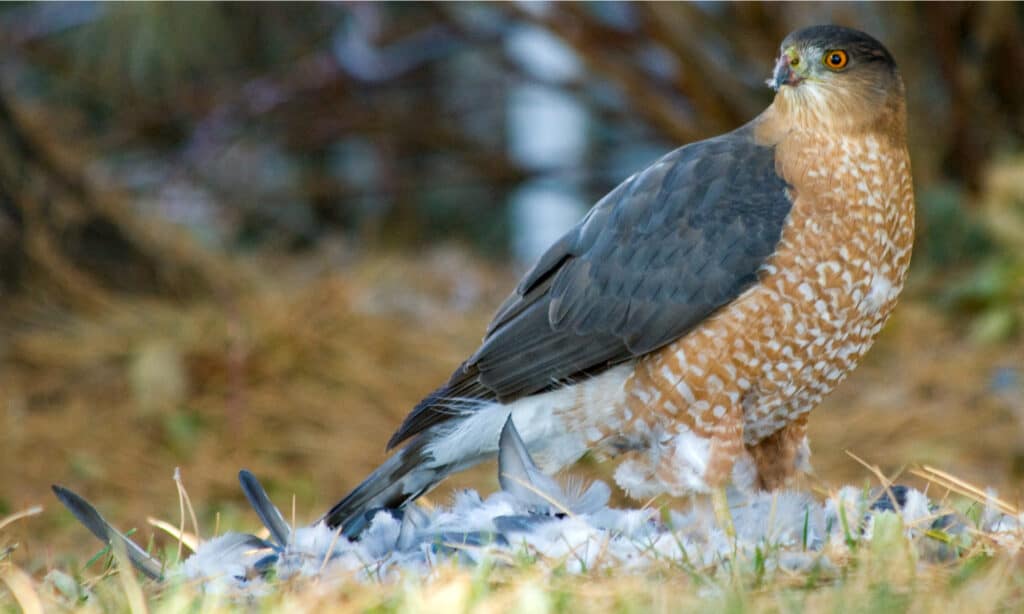
Sharp-shinned hawks are very similar to Cooper’s hawks from the grayish crown to reddish eyes but are smaller.
©Wyatt W/Shutterstock.com
| Sharp-Shinned Hawk | |
|---|---|
| Scientific name | Accipiter striatus |
| Weight | 2.9-7.7 oz (82-219 g) |
| Height | 9.1-15 in (23-37 cm) |
| Wingspan | 17-27 in (42-68 cm) |
Sharp-shinned hawks are very similar to Cooper’s hawks, from the grayish crown to reddish eyes but are smaller. Their wings are also short, with long tails and long legs. You can hardly see their small heads while soaring in the sky. Female sharp-shinned hawks are more significant than males.
Sharp-shinned hawks feed primarily on small birds, large insects, snakes, frogs, lizards, squirrels, and rodents. Due to their small size, they have many predators, from Cooper’s hawks and peregrine falcons to marsh hawks and red-tailed hawks.
You can easily spot sharp-shinned hawks in open habitats during the non-breeding seasons. They build their nests in deep forests with aspens and conifers. They breed once a year, and the females lay around four to five eggs.
7. Zone-Tailed Hawk
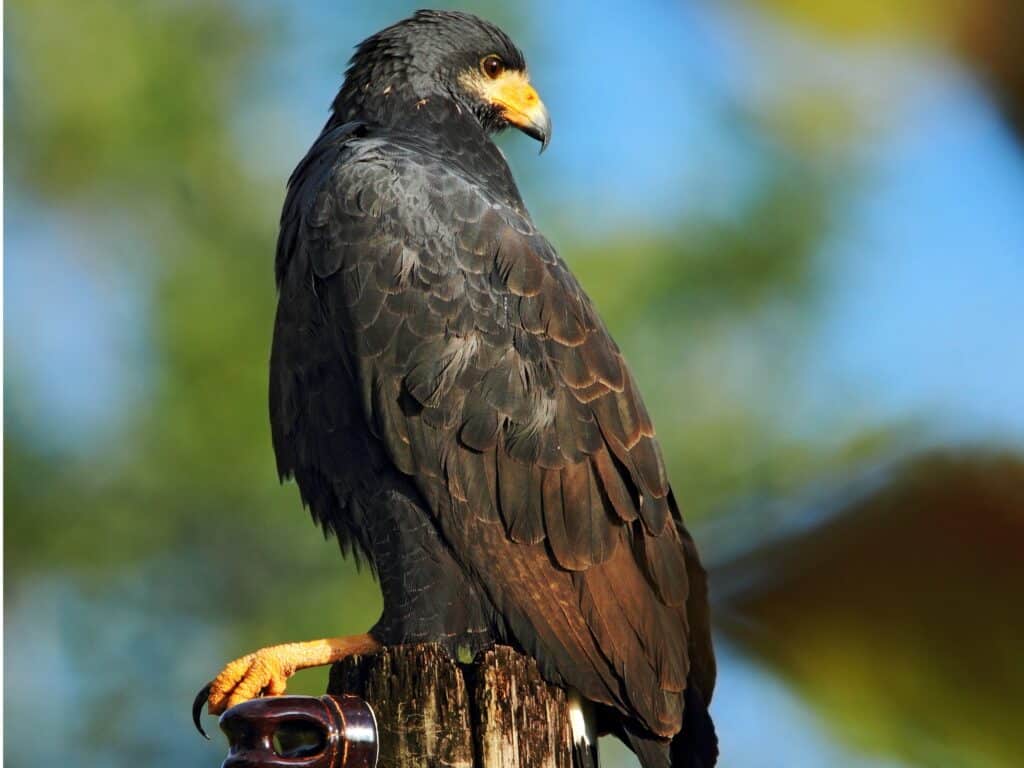
Zone-tailed hawks build their nests in the crotch of a tall tree, usually pine or oak.
©iStock.com/Ondrej Prosicky
| Zone-Tailed Hawk | |
|---|---|
| Scientific name | Buteo albonotatus |
| Weight | 1.25–2.38 lbs (565–1,080 g) |
| Height | 18 to 22 in (45-56 cm) |
| Wingspan | 46–55 in (117-140 cm) |
Zone-tailed hawks are medium-sized birds of prey that live in deserts or large trees. They have relatively slender wings with long tails. They are grayish-black with white and black banded tails.
These hawks eat insects, frogs, lizards, snakes, voles, rabbits, mice, and other small mammals. They hunt by flying low and slowly over treetops. They prefer dropping on prey from low heights.
Zone-tailed hawks build their nests in the crotch of a tall tree, usually pine or oak. Females lay between one and five eggs, and the incubation period takes around 28-35 days.
8. Red-Shouldered Hawk
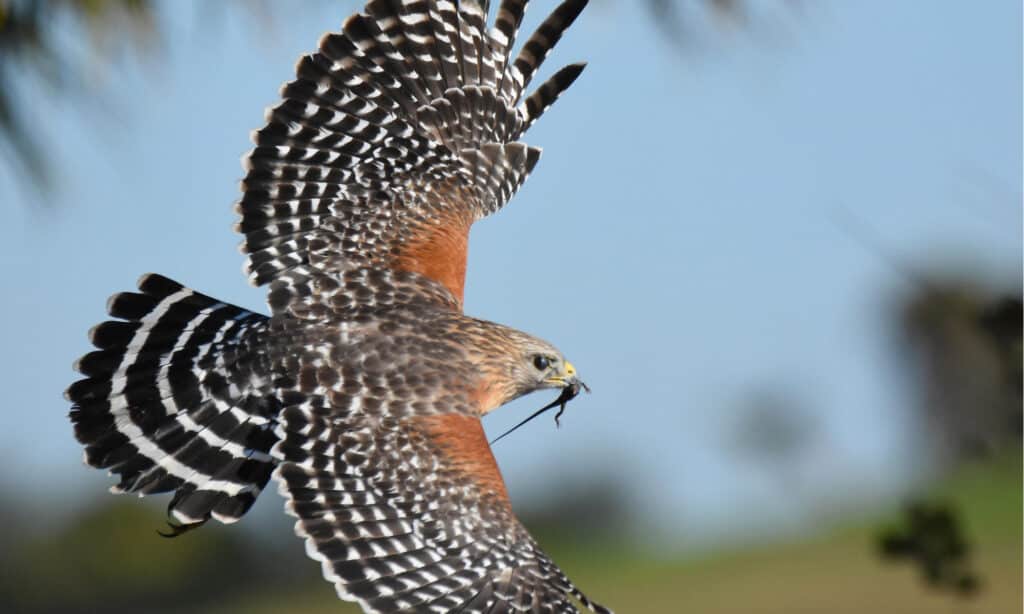
Red-shouldered hawks have very distinctive dark-and-white checkered wings with white-banded tails.
©MTKhaled mahmud/Shutterstock.com
| Red-Shouldered Hawk | |
|---|---|
| Scientific name | Buteo lineatus |
| Weight | 1-1.7 lbs (486-774g) |
| Height | 15-24 in (38-61 cm) |
| Wingspan | 35-50 in (90-127 cm) |
Red-shouldered hawks are very common in California. They are medium-sized hawks with rounded wings. They have very distinctive dark-and-white checkered wings with white-banded tails.
These hawks hunt insects, crayfish, lizards, frogs, snakes, rodents, and rabbits. They spend most of their time perched up on trees or soaring over the forests in search of a meal. Red-shouldered hawks are susceptible to attacks by martens, peregrine falcons, raccoons, great horned owls, and red-tailed hawks.
Their preferred habitats are swamps, wooded stream banks, and bottomlands. They move to open places in the winter. They nest along rivers and swamps or in deciduous and mixed forests. Females lay two to four eggs, and incubation lasts for about 33 days.
9. Northern Harrier

Northern harriers are slim, medium-sized birds of prey with rounded tails and broad wings.
©Harry Collins Photography/Shutterstock.com
| Northern Harrier | |
|---|---|
| Scientific name | Circus hudsonius |
| Weight | 11-27 oz (300-750 g) |
| Height | 21-25 in (53-64cm) |
| Wingspan | 41-46 in (103-117 cm) |
Northern harriers can be spotted in California year-round. They are very distinctive types of hawks that prefer breeding in wide-open habitats that range from marshes, fields, prairie grasslands, and Arctic tundra.
Northern harriers are slim, medium-sized birds of prey with rounded tails and broad wings. They have a particularly flat face, like owls, with a sharply hooked bill. They vary from gray to brown above, with black-banded tails. Their undersides are whitish with brown streaks.
Their diet consists of other small birds, rabbits, voles, mice, and reptiles. Feral cats, foxes, raccoons, skunks, and other large birds prey on northern harriers and their nestlings. Therefore, breeding mates have to protect their nests from potential predators since they normally build their nests on the ground.
10. Broad-Winged Hawk
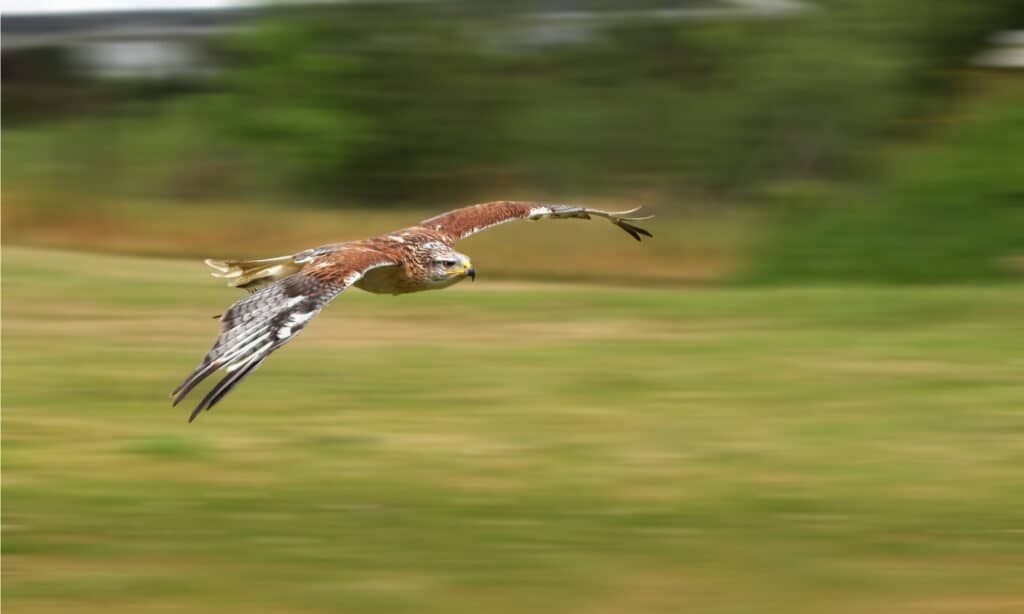
Broad-winged hawks mainly feed on young turtles, snakes, frogs, toads, lizards, squirrels, voles, mice, etc.
©pr2is/Shutterstock.com
| Broad-Winged Hawk | |
|---|---|
| Scientific name | Buteo platypterus |
| Weight | 9.3-19.8 oz (264-561 g) |
| Height | 13.4-17.3 in (34-44 cm) |
| Wingspan | 31.9-39.4 in (81-100 cm) |
Broad-winged hawks are medium-sized raptors with large reddish-brown heads and chunky bodies. Their underneaths are dark brown, while their tails are black or white.
Broad-winged hawks mainly feed on young turtles, snakes, frogs, toads, lizards, squirrels, voles, mice, and small birds, and sometimes they eat earthworms and fish. They hunt these animals from low perches underneath the forest canopy.
These birds inhabit the forests and build their nests underneath the canopy, usually the first main crotch of tree branches. Females lay two to four eggs, incubating for around 31 days.
11. Northern Goshawk

Northern goshawks are large hawks with distinctive gray crowns, gray backs, and gray barrings on their bellies.
©Milan Zygmunt/Shutterstock.com
| Northern Goshawk | |
|---|---|
| Scientific name | Accipiter gentilis |
| Weight | 1.4-4.8 lbs (635-2177 g) |
| Height | 18-27 in (46-69 cm) |
| Wingspan | 40-46 in (103-117 cm) |
Northern goshawks are large hawks with distinctive gray crowns, gray backs, and gray barrings on their bellies. Northern parts of California are the best places to watch for northern goshawks throughout the year.
Their main prey consists of snowshoe hares, rabbits, squirrels, crows, and many small birds and mammals. They watch for prey on high perches, and they can attack it quickly, even with a cluttered understory, because they fly with slow wingbeats complemented by short glides.
An adult northern goshawk rarely falls prey to predators except humans. However, their young ones are prone to attack by great horned owls and martens. Northern goshawks inhabit coniferous forests, though you may also spot them in deciduous hardwood forests.
12. Gray Hawk
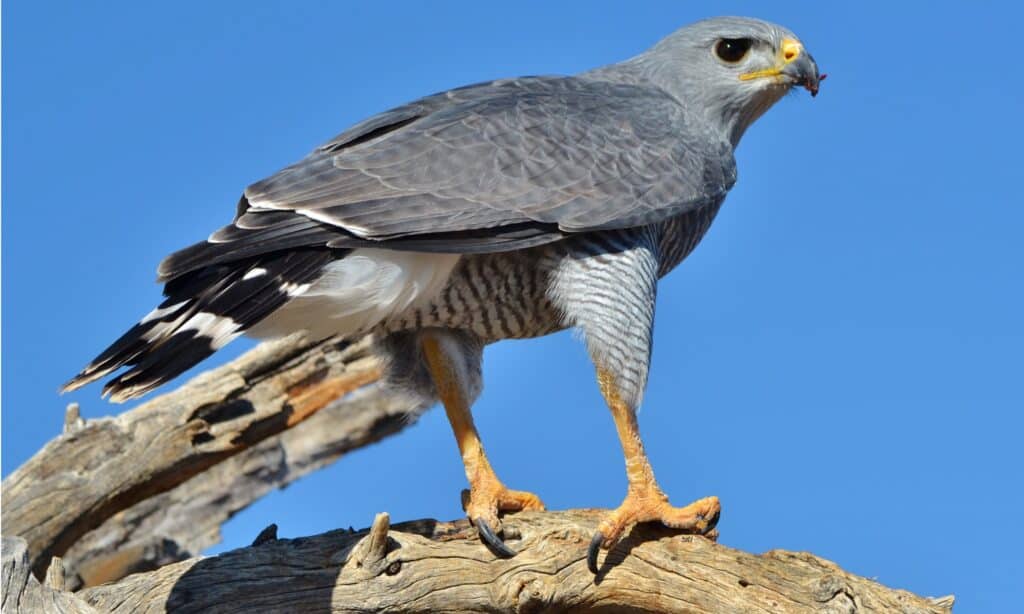
Gray hawks inhabit forest edges, savannahs, and woodlands during non-breeding seasons.
©iStock.com/mjf795
| Gray Hawk | |
|---|---|
| Scientific name | Buteo plagiatus |
| Weight | 13.8-16.6 oz (391-470 g) |
| Height | 18–24 in (46–61 cm) |
| Wingspan | 32-39 in (82-98 cm) |
Gray hawks are medium-sized birds of prey with short, broad wings. They are pale gray with white and black banded tails. Their young ones are dark brown on top with brown spots underneath.
These hawks have a diet that consists of large insects, small birds, rodents, lizards, and small mammals. They perch below the forest canopy in search of prey or soar just above the canopy to facilitate short flights to the ground upon sighting a prey. Golden eagles and great horned owls prey on gray hawks.
Gray hawks inhabit forest edges, savannahs, and woodlands during non-breeding seasons. They nest in cottonwoods during breeding seasons. Females lay between one and four eggs, and incubation lasts for about 32–34 days.
13. Harris’s Hawk
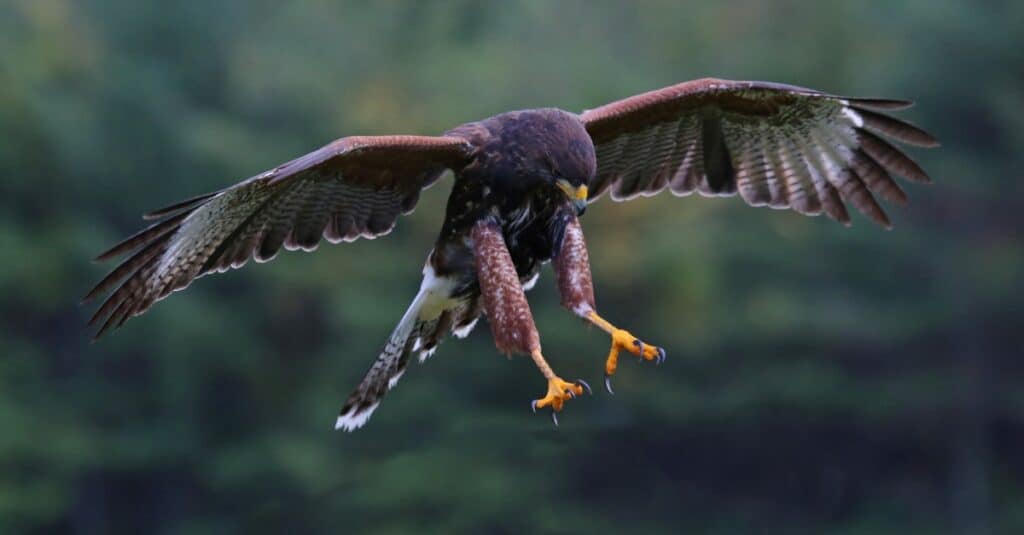
Harris’s hawks build their nests in some tall cliffs, mesquite trees, and in the saguaro cactus.
©iStock.com/ca2hill
| Harris’s Hawk | |
|---|---|
| Scientific name | Parabuteo unicinctus |
| Weight | 18-31 oz (515-880 g) |
| Height | 18 to 23 in (46-59 cm) |
| Wingspan | 41 to 47 in (103 to 120 cm) |
Harris’s hawks are large brown hawks with reddish feathers and bright-colored shoulders. Females are more significant than males. They inhabit the semi-arid desert lowlands and sometimes frequent urban and suburban areas searching for food and water.
These hawks have a diet that consists of reptiles, ground squirrels, rabbits, hares, quails, and other medium-sized birds. They may also fall prey to ravens, coyotes, and great horned owls.
Harris’s hawks build their nests in some tall cliffs, mesquite trees, and in the saguaro cactus. Females lay up to five eggs, and the incubation period lasts for 31-36 days.
14. Common Black Hawk
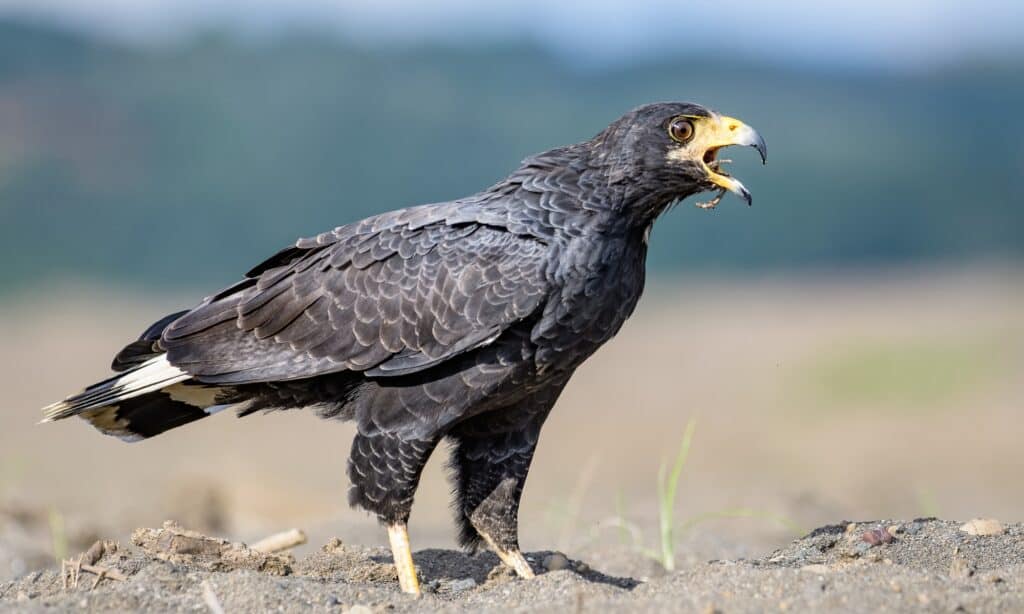
Common black hawks are commonly found in coastal mangrove swamps, mountain rivers, and lowland rainforests.
©iStock.com/Thorsten Spoerlein
| Common Black Hawk | |
|---|---|
| Scientific name | Buteogallus anthracinus |
| Weight | 1.7-2.6 lbs (793-1200 g) |
| Height | 17–21 in (43–53 cm) |
| Wingspan | 48-50 in (122-127 cm) |
Common black hawks are medium-sized birds of prey with broad wings and short tails. They are called common black hawks, though they have distinctive white-banded tails and yellow bills and legs. Immature birds are streaky brown. These hawks are rare in the US but are commonly sighted in California.
Common black hawks have a diet that mainly consists of fish, rodents, frogs, ants, and other small mammals. There are no natural predators of common black hawks. However, their nestlings are susceptible to attack by other birds if left alone.
Common black hawks are commonly found in coastal mangrove swamps, mountain rivers, and lowland rainforests. They are mostly found near water, breeding in tall trees, especially cottonwoods.
The photo featured at the top of this post is © Lowell Monke/Shutterstock.com
Thank you for reading! Have some feedback for us? Contact the AZ Animals editorial team.







